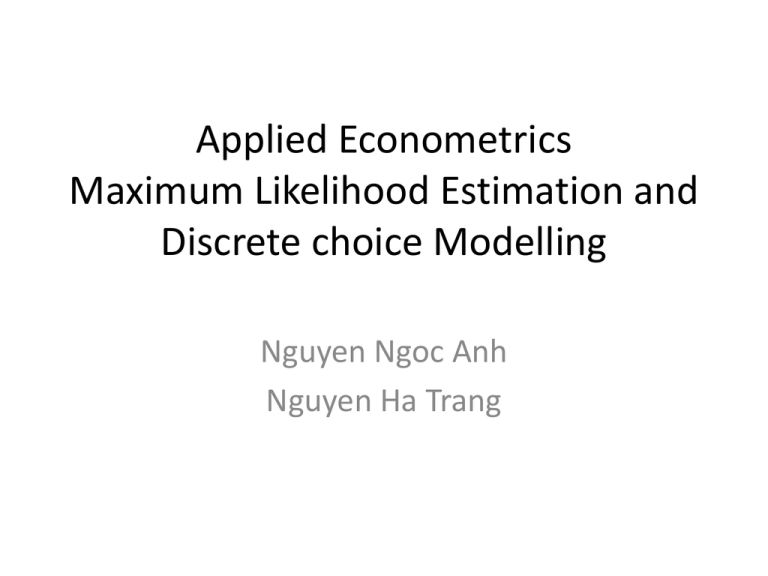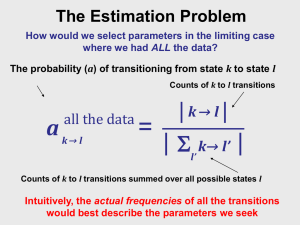Applied Econometrics Maximum Likelihood Estimation
advertisement

Applied Econometrics Maximum Likelihood Estimation and Discrete choice Modelling Nguyen Ngoc Anh Nguyen Ha Trang Content • Basic introduction to principle of Maximum Likelihood Estimation • Binary choice • RUM • Extending the binary choice – Mutinomial – Ordinal Maximum Likelihood Estimation • Back to square ONE • Population model: Y = α + βX + ε – Assume that the true slope is positive, so β > 0 • Sample model: Y = a + bX + e – Least squares (LS) estimator of β: bLS = (X′X)–1X′Y = Cov(X,Y) / Var(X) ˆ1 x x y x x i 2 i • Key assumptions – E(|x) = E( ) = 0 Cov(x, ) = E(x ) = 0 – Adding: Error Normality Assumption – e is idd with normal distribution i Maximum Likelihood Estimation • joint estimation of all the unknown parameters of a statistical model. • that the model in question be completely specified. • Complete specification of the model includes specifying the specific form of the probability distribution of the model's random variables. • joint estimation of the regression coefficient vector β and the scalar error variance σ2. Maximum Likelihood Estimation • Step 1: Formulation of the sample likelihood function • Step 2: Maximization of the sample likelihood function with respect to the unknown parameters β and σ2 . Maximum Likelihood Estimation • Step 1 • Normal Distribution Function: if Then we have the density function From our assumption with e or u Maximum Likelihood Estimation • Substitute for Y: • By random sampling, we have N independent observations, each with a pdf • joint pdf of all N sample values of Yi can be written as Maximum Likelihood Estimation • Substitute for Y Maximum Likelihood Estimation • the joint pdf f(y) is the sample likelihood function for the sample of N independent observations • The key difference between the joint pdf and the sample likelihood function is their interpretation, not their form. Maximum Likelihood Estimation • The joint pdf is interpreted as a function of the observable random variables for given values of the parameters and • The sample likelihood function is interpreted as a function of the parameters β and σ2 for given values of the observable variables Maximum Likelihood Estimation • STEP 2: Maximization of the Sample likelihood Function • Equivalence of maximizing the likelihood and log-likelihood functions : Because the natural logarithm is a positive monotonic transformation, the values of β and σthat maximize the likelihood function are the same as those that maximize the log-likelihood function • take the natural logarithm of the sample likelihood function to obtain the sample loglikelihood function. Maximum Likelihood Estimation • Differentiation and prove that • MLE estimates is the same as OLS Maximum Likelihood Estimation Statistical Properties of the ML Parameter Estimators 1. Consistency 2. 2. Asymptotic efficiency 3. Asymptotic normality Shares the small sample properties of the OLS coefficient estimator Binary Response Models: Linear Probability Model, Logit, and Probit • Many economic phenomena of interest, however, concern variables that are not continuous or perhaps not even quantitative – What characteristics (e.g. parental) affect the likelihood that an individual obtains a higher degree? – What determines labour force participation (employed vs not employed)? – What factors drive the incidence of civil war? Binary Response Models • Consider the linear regression model • Quantity of interest Binary Response Models • the change in the probability that Yi = 1 associated with a one-unit increase in Xj, holding constant the values of all other explanatory variables Binary Response Models Binary Response Models • Two Major limitation of OLS Estimation of BDV Models – Predictions outside the unit interval [0, 1] – The error terms ui are heteroskedastic – i.e., have nonconstant variances. Binary Response Models: Logit - Probit • Link function approach Binary Response Models • Latent variable approach • The problem is that we do not observe y*i. Instead, we observe the binary variable Binary Response Models Binary Response Models • Random utility model Binary Response Models • Maximum Likelihood estimation • Measuring the Goodness of Fit Binary Response Models • Interpreting the results: Marginal effects – In a binary outcome model, a given marginal effect is the ceteris paribus effect of changing one individual characteristic upon an individual’s probability of ‘success’. STATA Example • • • • Logitprobit.dta Logitprobit description STATA command Probit/logit inlf nwifeinc ed exp expsq age kidslt6 kidsge6 • dprobit inlf nwifeinc ed exp expsq age kidslt6 kidsge6







